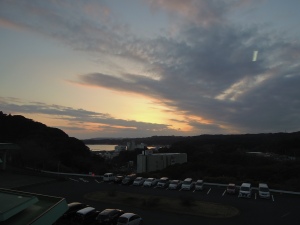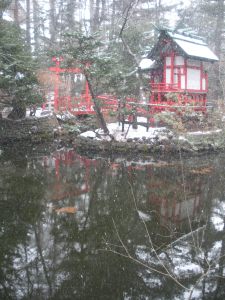
Sunset from the dormitory hallway
The panel was followed by a keynote lecture by Okazaki Hiroshi-sensei (Hanshi 8-dan) on some characteristics of kyudo. Kyudo is a but different from the other 8 modern martial arts because there is never an opponent, unless you count the target as the opponent. What that means is that your opponent becomes only yourself, which makes the physiological/ spiritual battle especially difficult in kyudo. This is often expressed with the phrase that “the target is a mirror”. In mere sports, it is just about winning physically, which is why there are doping scandels etc. in the Olympics. But in budo, it is also a spiritual challenge. Afterall, anyone can hit a paper target with an arrow, but in kyudo there needs to be a spiritual stablity/fullness to the shot. Thus in kyudo there are considered three “sicknesses”: hayake (早気 realizing too soon), yurumi (緩み collapsing the release), and busuki (不数寄 not practicing enough). These sicknesses are caused less by physical characteristics, but by spiritual weakness. Personally, I have found this to be very much so in my own practice: if I am feeling depressed or bashful (something to which I am genetically prone), I find it very difficult to avoid lapsing into a yurumi style of release. Westerners tends to dismiss any idea of spirit having physical influence, but phenomena like the placebo effect and psychosomatic illness demonstrate how our mind/spirit affects our bodies physically. Anyway, Okazaki-sensei also talked about the importance of benevolence (仁) and human relations in kyudo, as illustrated by the proverb “To shoot is the Way of Benevolence” (射は仁の道也). Those skilled at kyudo (“senpai”) and act all arrogant are like small scared animals, puffing themselves up in the hopes of frightening away a larger preditor. Senpai should explain things simply to beginners and those less skilled at kyudo (“kouhai”), just as a mother uses babytalk to an infant, but proper language to a teenager. The lack of benevolence in overseas kyudo groups seems to be a widespread problem, but I won’t go into that now.
After these morning lectures, there were demonstrations of all the modern martial arts by the teachers and then we were able to experience different budos for two short sessions. I tried Jukendo (bayonet) and Karate. Jukendo is associated with the SDF, so the teachers were two kindly but brusk military men assisted by two extremely cute and talented girls. This time, we tried learning only the dagger, since that is generally with what beginners start. I really think Jukendo is so cool, which is why I chose it, but to be honest it doesn’t fit my timid personality that well. We practiced thrusting at the abdominen, head, etc. and I find being asked to strongly whack my poor opponent over and over again quite emotionally distressing. She insisted it didn’t hurt, but all the same I felt really bad for doing it. Despite this–or perhaps because of this–I found it a very good chance to understand the more energetic side of budo and I hope I have a chance to try it again. In the second session I tried Karate. Karate is of course well known in the West, but I haven’t had that much exposure to it. We practiced kata, which meant I didn’t have to physically hit anyone, which was nice. I was impressed by the importance of keeping careful control of your speed (ie: speeding up at only the last second) when punching. It reminded me of how the correct modernation of speed (faster at certain times, slower at other times) is so important in almost all Japanese arts, not just martial arts. I have a tendency to be too slow all the time, so it is something I need to work on.
In the evening, we had a cocktail party (懇親会), which was pretty fun. I surprised that it was only at this party that the 150th anniversary of Meiji was mentioned. I had expected it to be celebrated a bit more promently. The speaker said something like “you guys probably don’t care much about the anniversary of Meiji, but…”, which I thought was a bit of a sad statement. Personally, I do care about it because I am a great fan of the Meiji period and emperor, but even setting that aside, I felt like the speaker should have confidence and explain to everyone the importance of Meiji’s anniversary. There was pretty nice food and I was able to chat with my roommate and other participants. Randy Channell, a Canadian tea master (Urasenke school), also had a somewhat impromptu tea ceremony with a rather charming selection of tea utensils gathered from around the world: a metal chaki from India, an antique Chinese kensui, and a teabowl made by a Canadian potter in Japan. The chashaku was carved by the retired headmaster of Urasenke and was named (something like) “Friendship throughout the World”. It was quite interesting to see the casual tea ritual of someone who has been studying tea longer than I’ve been alive… In the evening, after nipping back to the kyudojo for a bit more practice, many participants gathered on the fourth floor for some raucous drinking and talent show. I am not generally one for late night drinking parties, but I enjoyed the Russians’ folk dancing and had a rather fasincating conversation with another kyudo practitioner. During this, an American participant kept flashing looks at me, so I brought him up to teach him a touristy hula (E Huli Makou) as a part of the talent show. It was quite an effort since I had to sing the song, as well as dance the hula, all while wearing kimono. I was a bit embrassed, but four or five people came up to me the next day saying how much they liked my hula (!), so it seems it wasn’t that bad. This experience did make me think about the creation and passing down of traditions however. Many people could just suddenly stand up and perform folk songs/dance or sing karaoke, or do magic tricks, but the American fellow insisted he didn’t have anything he could do. I think that is probably true for many Americans and it makes me think American culture is a bit impovershed in that aspect. In Hawai’i, ukulele music is often just randomly performed for fun in just anyplace, and likewise hula is often danced in an impromptu manner. But I can’t think of any art in general American culture which can be done in a similar manner.
Since this post is rather long, I’ve broken it into three parts: 1, 2, and 3.




